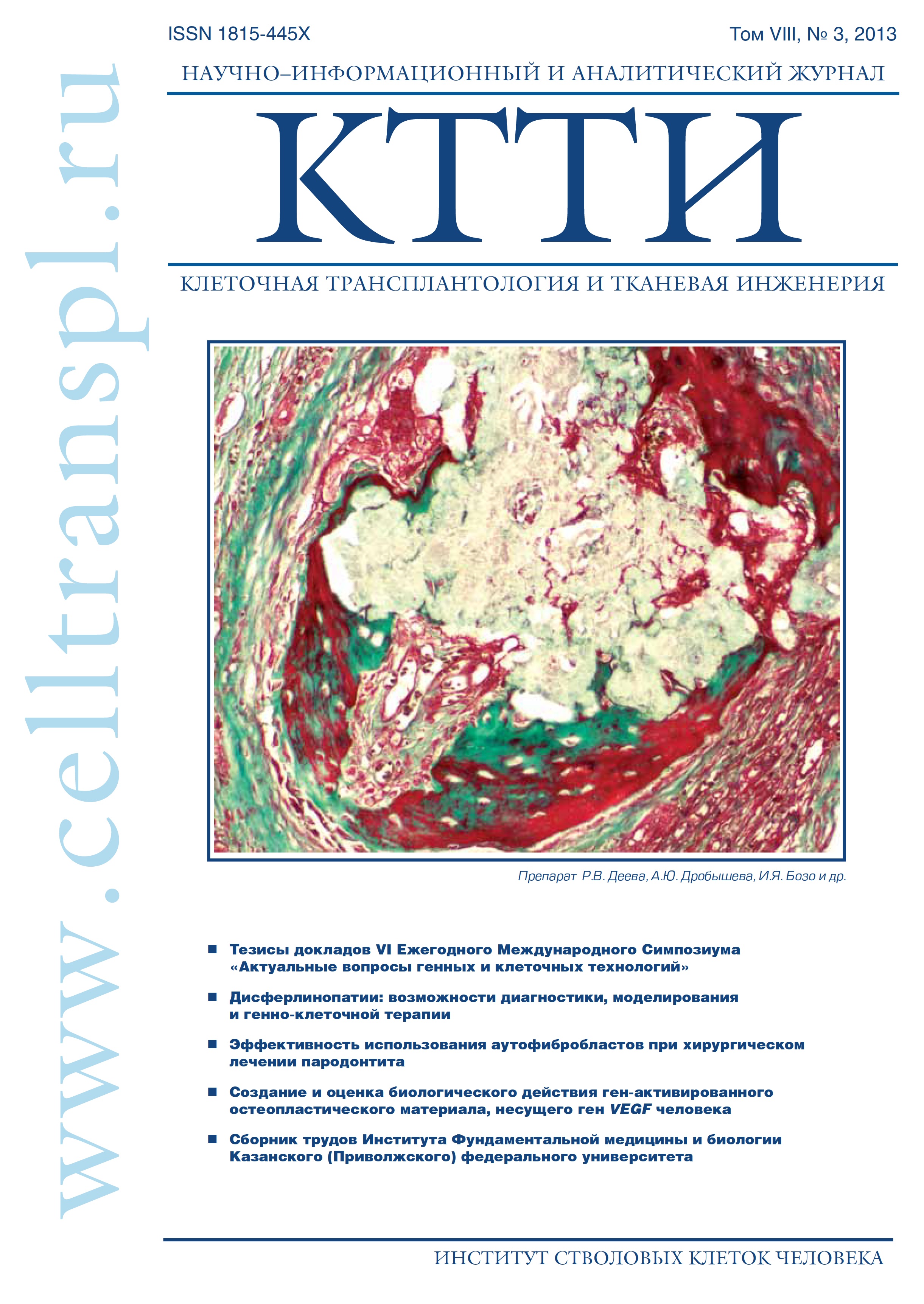Efficiency of autofibroblasts in surgical treatment of parodontitis
- Autores: Grudyanov A.I1, Zorin V.L2, Pereverzev R.V1, Zorina A.I2, Bozo I.Y2,3
-
Afiliações:
- Central Research Institute of Dentistry and maxillofacial surgery of MH Russia
- Human Stem Cells Institute
- A.I. Evdokimov Moscow State University of Medicine and Dentistry
- Edição: Volume 8, Nº 3 (2013)
- Páginas: 72-77
- Seção: Articles
- ##submission.dateSubmitted##: 05.01.2023
- ##submission.datePublished##: 15.10.2013
- URL: https://genescells.ru/2313-1829/article/view/120544
- DOI: https://doi.org/10.23868/gc120544
- ID: 120544
Citar
Texto integral
Resumo
The destructive forms of periodontal disease have a high prevalence. Our study was aimed to evaluate the effectiveness of tissue-engineering osteoplastic material in treatment of patients with periodontal pathology. We have obtained autologous gingival fibroblasts of patients, combined with the hydroxyapatite carriage and transplanted on a standard surgical treatment of periodontitis destructive forms. As a control we used the material without cells implanted into periodontal defects of other affected teeth of the same patients. We have shown the better effect of tissue-engineering osteoplastic material regarding the periodontal pockets depth, but significant difference in bone regeneration and other indicators has not been revealed. Thus, a continuation of researches is required to modify the technology of tissueengineering osteoplastic material creation and to choice the more optimal carrier for gingival fibroblasts.
Texto integral
Sobre autores
A. Grudyanov
Central Research Institute of Dentistry and maxillofacial surgery of MH RussiaMoscow
V. Zorin
Human Stem Cells InstituteMoscow
R. Pereverzev
Central Research Institute of Dentistry and maxillofacial surgery of MH RussiaMoscow
A. Zorina
Human Stem Cells InstituteMoscow
I. Bozo
Human Stem Cells Institute; A.I. Evdokimov Moscow State University of Medicine and DentistryMoscow
Bibliografia
- Безрукова И.В. Быстропрогрессирующий пародонтит. М.: Медицинская книга; 2004.
- Григорьян А.С., Грудянов А.И., Фролова О.А. и др. Видовой состав анаэробной микрофлоры пародонтального кармана в зависимости от стадии пародонтита. Стоматология 2009; 4: 43-7.
- Грудянов А.И. Заболевания пародонта. М.: Медицинское информационное агентство; 2009.
- Petersen P.E., Ogawa H. Strengthening the prevention of periodontal disease: the WHO approach. Periodontol 2005; 76: 2187-93.
- Григорьян А.С., Грудянов А.И., Рабухина Н.А. Болезни паро-донта: патогенез, диагностика, лечение. М.: Медицинское информационное агентство; 2004.
- Bowers G.M., Chadroff B., Carnevale R. et al. Histologic evaluation of new attachment apparatus formation in humans. Part III. Periodontol. 1989; 60(12): 683-93.
- Cortellini P, Bowers G. Periodontal regeneration of intrabony defects: An evidence based treatment approach. Int. J. Periodontol. Rest. Dent. 1995; 15:128-45.
- Гололобов В.Г., Дулаев А.К., Деев Р.В. и д.р. Морфофункциональная организация, реактивность и регенерация костной ткани. СПб: 2006; 47 с.
- Зорин В.Л., Зорина А.И., Воложин Г.А. и др. Изучение фенотипического профиля и остеогенных свойств фибробластов десны. Саратовский научно-медицинский журнал 2013; 9(3): 393-7.
- Lorenz K., Sicker M., Schmelzer E. et al. Multilineage differentiation potential of human dermal skin-derived fibroblasts. Exp. Dermatol. 2008; 17(11): 925-32
- Mostafa N.Z., Uludag H., Varkey M. et al. In vitro osteogenic induction of human gingival fibroblasts for bone regeneration. Open Dent J. 2011;5:139-45.
- Huang G.T., Gronthos S., Shi S. Mesenchymal stem cells derived from dental tissues vs. those from other sources: their biology and role in regenerative medicine. J. Dent. Res. 2009; 88(9): 792806.
- Guo W., Chen L., Gong K. et al. Heterogeneous dental follicle cells and the regeneration of complex periodontal tissues. Tissue Eng. Part A. 2012; 18(5-6): 459-70.
Arquivos suplementares









